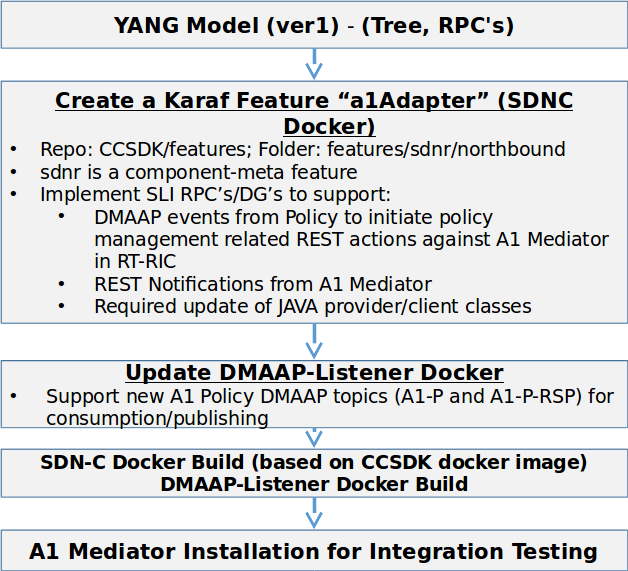1. Background
The O-RAN architecture includes a Real-Time (RT) Radio Intelligent Controller (RIC) that is connected via A1 interface to Non-Real Time RIC function that resides in the Service Management and Orchestration (SMO) layer. The purpose of A1 interface is to enable Non-RT RIC function to provide policy-based guidance, AI/ML model management, and enrichment information to the near-RT RIC for RAN optimization.
2. High-Level Architecture and Use Cases
The overall Use Case Flow (DMAAP <--> SDNR/A1 REST Adapter <--> A1 Mediator) is as follows:
- Any ONAP or micro-service that wants to perform any policy management related activity will publish a DMAAP message, with appropriate request
- DMAAP listener will consume the DMAAP message and invoke RPC against A1 Adapter
- A1 Adapter, based on the received DMAAP message/RPC, will invoke corresponding REST API's against A1 Mediator in Near-RT RIC
The picture below depicts overall use case flow
3. High-Level Design and Implementation Approach
For Frankfurt, only A1 Policy Management is supported.
The solution leverages existing CCSDK/SDNR code base and SDNC Dmaap Listener, and below depicts implementation approach:
4. North-bound RPC YANG Model
YANG model for north-bound RPC's for A1 Adapter can be found at: https://gerrit.onap.org/r/gitweb?p=ccsdk/features.git;a=blob;f=sdnr/northbound/a1Adapter/model/src/main/yang/A1-ADAPTER-API.yang;h=fb740cc2731ba8ab76977450b9bc31578bff9f16;hb=refs/heads/master
The below picture depicts the overall YANG tree.
5. DMAAP Message Format
Following are DMAAP message formats for topics A1-P and A1-P-RSP.
DMAAP Message Request (sent from ONAP or MS components):
Topic: A1-P { "body": { "input": { "CommonHeader": { "TimeStamp": "2018-11-30T09:13:37.368Z", "APIver": "1.0", "RequestID": "9d2d790e-a5f0-11e8-98d0-529269fb1459", "SubRequestID": "1", "RequestTrack": {}, "Flags": {} }, "Action": "getNearRT-RICs", "Payload": {"input": {"dummy": "dummy"}} }, "version": "1.0", "rpc-name": "getNearRT-RICs", "correlation-id": "9d2d790e-a5f0-11e8-98d0-529269fb1459-1", "type": "request" } } |
|---|
DMAAP Message Response (sent from A1 Mediator with status response)
Topic: A1-P-RSP
{ "body": { "output": { "CommonHeader": { "TimeStamp": "2018-09-10T07:10:05.614Z", "APIver": "1.0", "RequestID": "9d2d790e-a5f0-11e8-98d0-529269fb1459", "SubRequestID": "1", "RequestTrack": [], "Flags": [] }, "Status": { "Code": 200, "Value": "SUCCESS" }, "Payload": "" } }, "version": "1.0", "rpc-name": "getNearRT-RICs", "correlation-id": "9d2d790e-a5f0-11e8-98d0-529269fb1459-1", "type": "response" } |
|---|
DMAAP message payload is aligned with YANG RPC Input parameters and is exactly the same as, when YANG model RPC input is rendered as a JSON object. See the above example, where DMAAP message is related to RPC "getNearRT-RICs".
IMPORTANT: Please note that “input” key needs to be included in the payload. Escape characters ARE NOT to be INCLUDED.




